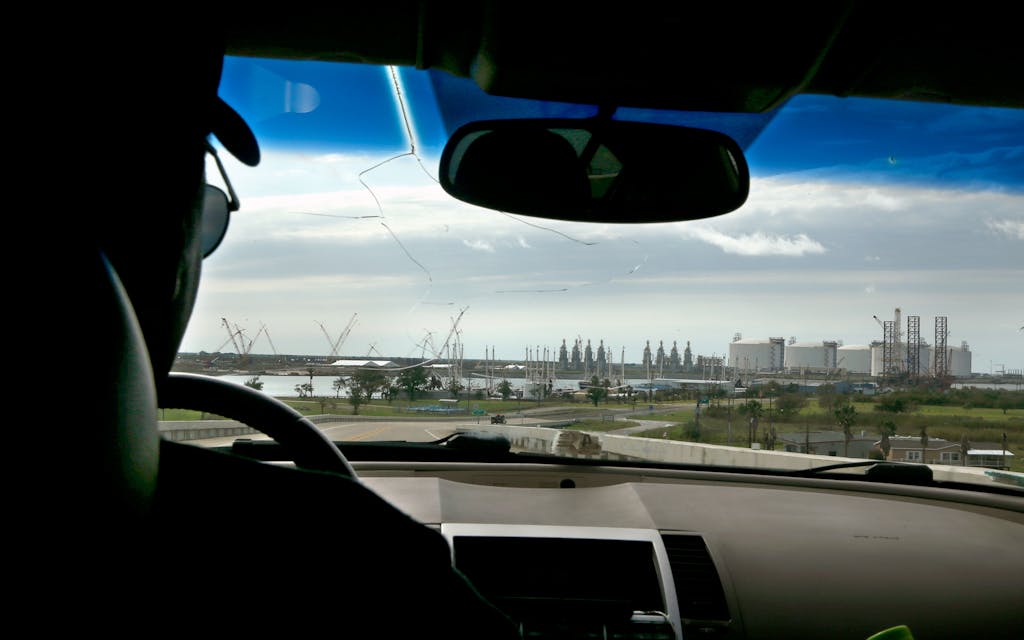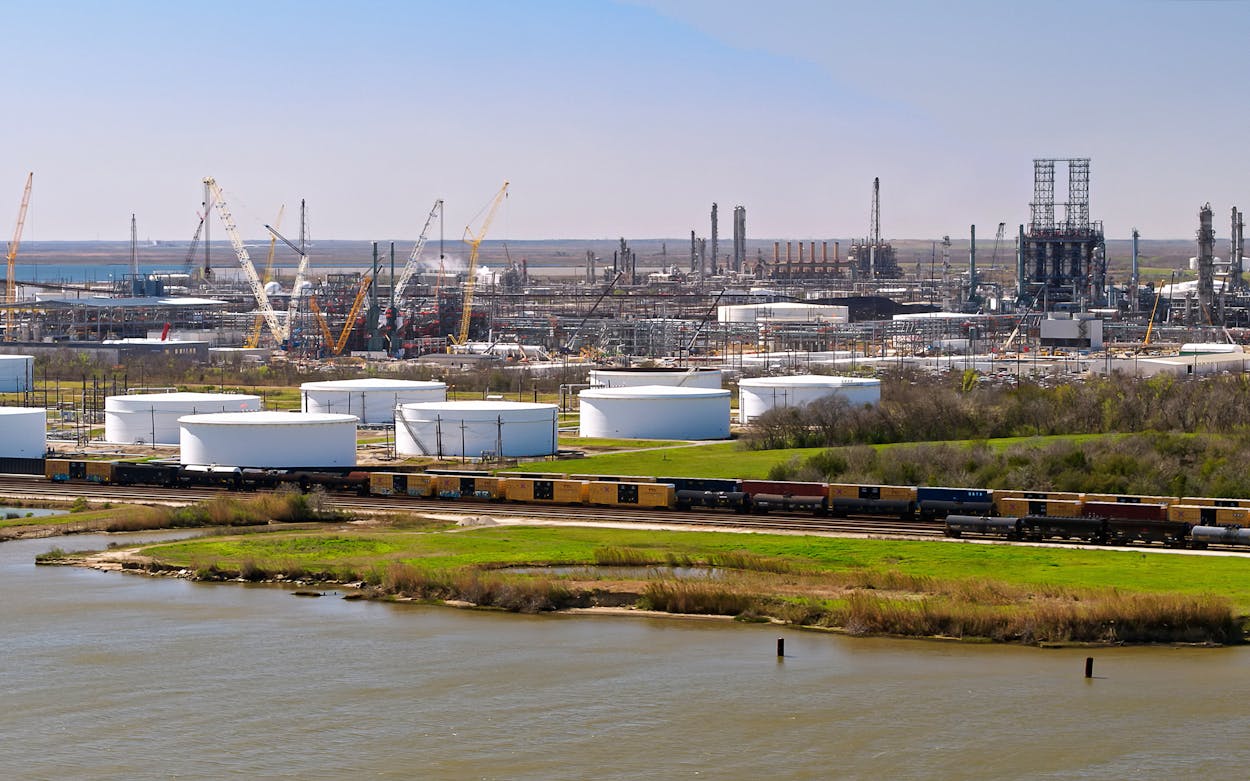As the rented minivan navigates the Houston suburbs and the first petrochemical facilities come into view, the reaction inside the vehicle is like there’s been a celebrity sighting. “Look over there,” says Constantin Zerger, at the wheel, pointing out a flare blazing over a refinery to the south, a method of burning off excess gas that is largely forbidden in his home country. He and the van’s five passengers—journalists and environmental activists visiting from Germany—lean toward the windows to get a better glimpse of the industrial sites they have traveled thousands of miles to see.
This trip, on a sunny day in November, has been organized around a subject that has lately occupied much of Zerger’s mind: liquefied natural gas. A trim and focused man in his forties, Zerger heads the energy and climate office of Deutsche Umwelthilfe (Environmental Action Germany), the nonprofit that covered the costs of bringing journalists from Germany to Texas to see for themselves the considerable industrial oil and gas buildup along the Gulf Coast. They had flown into Houston the previous day from Berlin, Frankfurt, and Washington to embark on a whistle-stop tour through Texas and Louisiana.
LNG, as it is commonly called, offers a method of transporting Texan natural gas to Europe; gas is cooled to -259 degrees Fahrenheit before being loaded onto specialized tankers. Germany operates three coastal terminals for receiving LNG and plans to bring another three online within twelve months. Over the next few years, Texas is set to add four export facilities to the two already operating in Corpus Christi and Freeport.
Deutsche Umwelthilfe’s aim in leading its November junket was to heighten concern among Germans about the environmental effects of LNG production in the United States. A new law in Germany allows companies to be penalized for human rights violations—defined as including major environmental degradation—in their supply chains.
Along with other European nations, Germany has turned increasingly to the United States, including Texas, for power. Natural gas runs roughly half of Germany’s home heating and some 30 percent of its industrial needs, and the outbreak of war in Ukraine disrupted the supply. Most of Germany’s gas previously came from Russia, even after Putin’s invasion of his neighbor. Not until September 2022 did Germany stop buying Russian fossil fuels, and then only because a vital pipeline was destroyed by an underwater explosion, for which some observers suspect pro-Ukrainian groups were responsible.
Though Germany now gets most of its natural gas from Norway, Texas has helped to replace the missing Russian gas with a more stable supply that’s subject to fewer political risks. Some 6.8 billion cubic feet per day of liquefied U.S. gas reached Europe in 2022, more than double the amount recorded in the previous year, and this fall Texas accounted for nearly one third of American LNG exports, second only to Louisiana.
After a ninety-mile drive east of Houston on Interstate 10, Zerger pulls the minivan into a motel parking lot in Port Arthur. There the group is greeted by John Beard, who runs the Port Arthur Community Action Network and whose booming voice and Texan drawl contrast starkly with Zerger’s spare and intense demeanor. As a former petrochemical worker, Beard is familiar with the dozens of refineries, export facilities, and other toxin-releasing sites that dot the city. He’s a voluble advocate for his hometown, the son of a preacher and prone to folksy expressions that play well to this audience. “Howdy, as we say in Texas,” he says in welcoming the visitors, to appreciative chuckles.
Beard announces to the group that Port Arthur is “in the belly of the beast,” and shortly thereafter, he herds a few journalists into another minivan to show them what he means. Like his German counterpart, Beard is prone to rattling off statistics, many of them related to the effects of pollution. “Our cancer rate here is ten percent above the national average,” he says. A recent report by ProPublica estimated the risk of cancer caused by industrial activity in Port Arthur to be as much as 190 times greater than is deemed acceptable by the U.S. Environmental Protection Agency.

Like the plurality of the city’s residents, Beard is Black. He has strong views about why Port Arthur bears the brunt of harmful industrial emissions: “It’s racism, plain and simple,” he says. On the west side of town, Beard points out two refineries and another half dozen petrochemical plants interspersed among residential neighborhoods. Relatively few of the billions of oil and gas dollars generated annually in Port Arthur stay here, Beard explains. “There’s not a single place to buy food in the neighborhood right now,” he says. “Look over there: even the dollar store shut down.” The per capita income in Port Arthur in 2022 was just $24,065, compared to the state’s $37,514. A quarter of the population lives below the federal poverty line.
Beard and Zerger meet up later at a bridge over Sabine Lake, which straddles the Texas-Louisiana border. Visible from their vantage point is Golden Pass LNG, an export terminal set to open next year, to be followed in 2027 by Port Arthur LNG. (In mid-November, the U.S. Fifth Circuit Court of Appeals vacated the emissions permit granted to Port Arthur LNG by the Texas Commission on Environmental Quality. The terminal will have to reapply, but its owner, San Diego–based Sempra, has said construction will continue without delay.)
Zerger explains that Germany is not merely a market for liquefied gas from the U.S. but also a significant investor in its production. Deutsche Bank alone has arranged for loans in the billions to help finance LNG facilities. A collaborative investigation by Deutsche Umwelthilfe and the Sierra Club estimates that some 4.5 billion euros from Germany have flowed into the U.S. LNG industry over the last decade. According to the report, one of Port Arthur LNG’s financiers is KfW IPEX-Bank—the international arm of the state bank that guarantees most student loans in Germany—which has contributed $356.9 million of the project’s total $13 billion cost. A representative of KfW IPEX-Bank declined to comment on the bank’s investments. The delivery contracts to German energy providers from the terminal will run for fifteen years or more.
Zerger laments that this LNG build-out could compromise Germany’s pledge to meet its climate goals. The country aims to be carbon-neutral by 2045. But a recent study by Robert Warren Howarth, a professor of ecology at Cornell University, posits that the transatlantic LNG trade may have a higher emissions footprint than coal—owing to the immense amounts of energy required for liquefaction, regasification, and shipping, as well as gas leakage from tankers and other infrastructure. (Howarth’s work is under peer review.)
The International Energy Agency estimates that 75 percent of methane emissions from the oil and gas industry could be eliminated by properly implementing existing safety measures. A representative of the American Petroleum Institute, which works on behalf of the industry, pointed to recent studies that show a reduction in overall methane emissions over the past decade. Electrification of some parts of the liquefaction process and upgrading existing equipment may further aid in the reduction of emissions in the places where LNG is produced, the API rep said.
“The terminals in Germany need these terminals in the U.S.,” Zerger says. “And the environmental destruction that takes place here through fracking and the export terminals is much larger than what we see at home.” Fracking is largely outlawed in the European Union, a fact that does not seem to influence the decision-making process in Germany regarding the sources of its gas. While the country has committed itself to an ambitious agenda of carbon dioxide emission reductions, it is also strengthening its ties to Texas and the Permian, the most productive oil basin in the U.S. and a major source of methane emissions. “In Germany this issue is often abstracted, but the fact is that we do not bear the brunt of the consequences of our lifestyle,” Zerger says. “Those are borne by the people here, largely by communities of color.”
While Deutsche Umwelthilfe didn’t oppose the building of the first two new import terminals to compensate for the lost Russian gas, it says the German government now needs to reel back its investments. For the coming winter, the German energy agency does not foresee any shortfalls in natural gas, with the country’s reservoirs at capacity thanks to a relatively mild winter last year, and weather in the coming months is expected to be similar. To Zerger, this fact is reason to cease the opening of additional LNG import terminals.
But with billions of euros already pledged to the build-out, there are few indications that these efforts will slow. The exchange is beneficial both for the German government’s ambition to keep its strategic reserves filled and for Texas’s gas sector, which employs some 100,000 people in well-paying jobs across the state. While numbers on employment in LNG specifically are not available, the industry representative pointed to a 2021 report by PricewaterhouseCoopers, which estimates that nearly 2.5 million jobs in Texas are dependent upon the oil and gas sector.
Later in the evening, Beard again addresses his visitors, in the parking lot of a Mexican restaurant after the group has shared a meal. “What happens here affects the world,” Beard says while motioning to the sprawl of Port Arthur. Zerger, to his right, nods appreciatively. “We’ve got to hold each other up,” Beard adds, before he embraces Zerger, who herds the journalists back to the minivans and onward to Louisiana.
- More About:
- Energy
- Business
- Port Arthur






